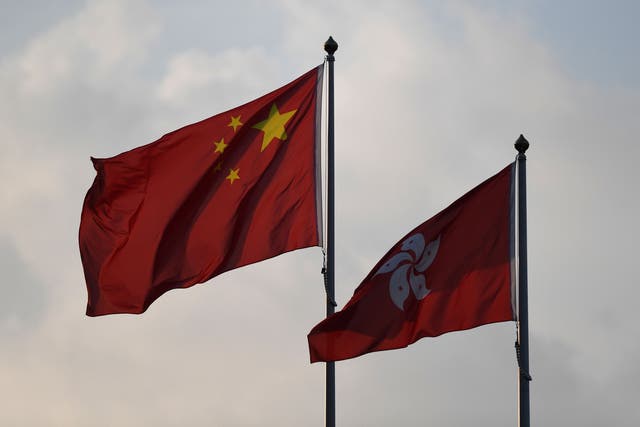
The arrangement began in 1997 as part of a gradual return of the territory to China from British colonial rule.
Updated: May 23, 2023 | Original: September 3, 2019

At midnight on July 1, 1997, Hong Kong returned to Chinese control after a century and a half of British colonial rule. The handover was meant to establish a “one country, two systems” relationship between China and Hong Kong that would last until 2047, with Hong Kong existing as a special administrative region.
Since the handover, Hong Kong residents have accused Beijing of overstepping its authority. The Umbrella Movement was a series of protests in 2014 that called for more transparent elections for the city’s chief executive. In early 2016, Hong Kong booksellers disappeared and later showed up in police custody in China. And in 2019 protests erupted in Hong Kong over a proposed bill to allow extradition to mainland China.
Here’s a look back at what led to Hong Kong’s unusual relationship with China.
Hong Kong first came under Chinese rule during the Qin Dynasty in the third century B.C., and it remained a part of the Chinese Empire for about 2,000 years. But between 1842 and 1898, the British Empire gradually seized control of the three main regions that make up modern-day Hong Kong: Hong Kong Island, the Kowloon Peninsula and the New Territories.
All of these regions were still under Chinese control when the empire went to war with the British Empire in 1839. This was the First Opium War, so called because China was trying to stop British drug traffickers from illegally smuggling opium into China (the trafficking had created an addiction crisis).
During the war, China temporarily ceded Hong Kong Island to the British Empire with the 1841 Convention of Chuenpi. When the war ended in 1842, the Treaty of Nanjing forced China to indefinitely cede the southern island to the British.
Control of Hong Kong Island gave the British Empire better access to Chinese trade. Eager for even more, it renewed fighting with China in 1856 and sparked the Second Opium War (which the French Empire also joined). When the war ended in 1860, the Convention of Beijing forced China to cede the Kowloon Peninsula south of a dividing line known as Boundary Street.
On July 1, 1898, the British Empire negotiated the Second Convention of Peking with China, this time leasing the New Territories between Boundary Street and Shenzhen River, the modern dividing line between mainland China and Hong Kong. The lease was set to expire in 99 years, meaning that China expected Britain to hand the region back over on July 1, 1997.
During World War II, the Japanese Empire briefly interrupted British control when it occupied Hong Kong (at the time, Japan was also occupying most of Southeast Asia). After the war, dozens of countries in Asia, Africa and the Americas won independence from Japanese and European control. But Britain continued to rule over Hong Kong, one of its last major colonial territories.
In 1982, with the expiration date for British control of the New Territories looming, British and Chinese leaders met with each other to negotiate the transition.
Because the 1898 lease didn’t apply to Hong Kong Island and the Kowloon Peninsula south of Boundary Street, Britain could have tried to negotiate keeping those regions. However, Prime Minister Margaret Thatcher ultimately didn’t think that those two regions would be able to survive on their own, says Steve Tsang, director of the University of London’s SOAS China Institute.
After all, Hong Kong’s airport—Shek Kong Airfield—was in the section above Boundary Street that the British had to return.
Britain decided that when the deadline arrived, it would hand over all of Hong Kong to China. Whether Hong Kong supported the handover wasn’t part of the discussion.
“What choice did they have?” Tsang asks. “If they said, ‘No negotiations,’ the Chinese would take over without a deal. If they declare independence, the PLA [People's Liberation Army] would invade. So neither of those are actually options—independence was not an option, refusing or rejecting integration was not an option.”
In 1984, the U.K. and China signed the Sino-British Joint Declaration outlining their plan for Hong Kong.
This declaration stipulated that Hong Kong would become a part of China on July 1, 1997, but that the “current social and economic systems” and “life-style” in Hong Kong would remain the same for 50 years. In this “one country, two systems” arrangement, Hong Kong would continue operating in a capitalist economy, and residents would continue to have rights to speech, press, assembly and religious belief, among others—at least until 2047.
In 2019, protests broke out over a proposed bill that many Hong Kong residents felt would violate the “one country, two systems” arrangement by allowing extradition to mainland China. The bill would allow local authorities to detain and extradite fugitive offenders who are wanted in territories that Hong Kong does not have extradition agreements with, including mainland China and Taiwan.
The bill's critics argued that it could lead to what some have described as "legalized kidnapping." At the time, some younger protesters expressed concern about what life will be like in Hong Kong when the expiration date for this arrangement passes in 2047.